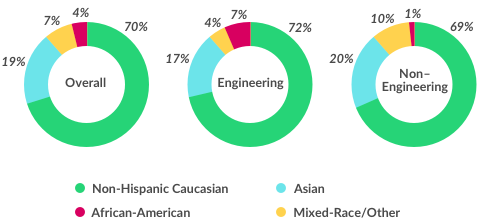The airing of a tech company’s diversity numbers has become a rite of passage in Silicon Valley.
And like other cliches in public discourse (see also: politicians resigning to “spend more time with family”), there is a script. It goes something like this: These are our values. Here’s the data. We know we have work to do.
Slack, the email-slaying chat platform and media darling, became the latest company to release such a statement on Wednesday. “We are doing many of the same things other companies are doing and have already described,” wrote Anne Toth, Slack’s vice president of people and policy, and Stewart Butterfield, the company’s CEO.
Toth and Butterfield revealed that 70 percent of Slack’s employees are white and 61 percent of them are men. Parsing those numbers further: 55 percent of the management roles at Slack are held by men, along with 82 percent of the engineering jobs.

It’s worth noting, Toth and Butterfield said, that while women don’t hold as many manager jobs as men at Slack, there are women in some of the most important leadership roles. “Fully 41 percent of all people working at Slack have a woman as their manager,” they wrote. “This means that 41 percent of our people report to a woman who helps set their priorities, measure their performance, mentor them in their work, and who make recommendations that will impact their compensation and career growth.”
Viewing Slack’s data more broadly, the company looks a lot like many of the top tech firms in the world. At Google, for example, 70 percent of the workforce is male and 60 percent of it is white, according to the latest data. At Apple, 69 percent of the workforce is male, and 54 percent of it is white.
Like tech execs at those companies, Toth and Butterfield promise to do better. Toth and Butterfield offered four concrete steps they plan to pursue to build their company in a way that aligns with their values. Their plan includes:
1. Examining all decisions regarding hiring/recruiting, promotion, compensation, employee recognition and management structure to ensure that we are not inadvertently advantaging one group over another.
2. Working with expert advisors and employees to build fair and inclusive processes for employee retention, such as effective management education, company-wide unconscious bias training, ally skills coaching, and compensation review.
3. Helping to address the pipeline issue with financial contributions to organizations whose mission is to educate and equip underrepresented groups with relevant technical skills (like Hack the Hood and Grace Hopper), as well as supporting a variety of internship programs to broaden access to opportunity (like CODE2040).
4. Attempting to be conscious and deliberate in our decision-making and the principles and values by which we operate. Changing our industry starts by building a workplace that is welcoming to all so that a generation of role models, examples and mentors is created.
There’s nothing radical in Slack’s four-point plan, but it touches on some themes worth noting—namely, that hiring diverse employees isn’t enough to change the culture of a business (or an entire industry, for that matter). Just counting employees by demographic, while revealing, is a blunt measure of how well a company is doing to create a culture that attracts a workforce that's simultaneously the most diverse and the most skilled. Which is why Toth and Butterfield's mention of retention rates, for example, is important.
Retention is one reason why some of the focus in the broader conversation about diversity in Silicon Valley has shifted to an examination of benefits like parental leave, too. (It’s worth reading Julia Cheiffetz’s account of how she was treated at Amazon after returning from maternity leave and cancer surgery.)
Hiring more women and people of color does little to improve a company’s culture if those hires aren’t promoted into leadership, or if workers perceive that minority workers aren’t offered comparable salaries or job titles for the same levels of performance and skill. From a business perspective, hiring a diverse workforce is a matter of pragmatism: It makes good economic sense to have employees reflect one's desired customer base. But the fact that inclusiveness is a matter of basic fairness should not be treated as an aside either. Doing what's right is a tenet the technology industry has insisted it believes in—even if it hasn't figured out how to act that way.
This article was originally published at http://www.theatlantic.com/technology/archive/2015/09/the-next-wave-of-diversity-disclosures-in-silicon-valley/404617/
